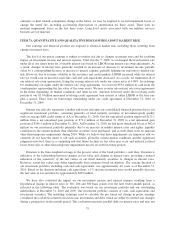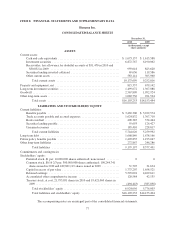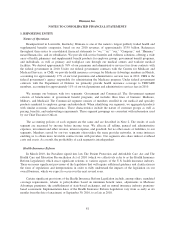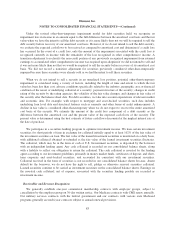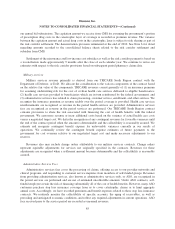Humana 2010 Annual Report Download - page 93
Download and view the complete annual report
Please find page 93 of the 2010 Humana annual report below. You can navigate through the pages in the report by either clicking on the pages listed below, or by using the keyword search tool below to find specific information within the annual report.Humana Inc.
NOTES TO CONSOLIDATED FINANCIAL STATEMENTS—(Continued)
Under the revised other-than-temporary impairment model for debt securities held, we recognize an
impairment loss in income in an amount equal to the full difference between the amortized cost basis and the fair
value when we have the intent to sell the debt security or it is more likely than not we will be required to sell the
debt security before recovery of our amortized cost basis. However, if we do not intend to sell the debt security,
we evaluate the expected cash flows to be received as compared to amortized cost and determine if a credit loss
has occurred. In the event of a credit loss, only the amount of the impairment associated with the credit loss is
recognized currently in income with the remainder of the loss recognized in other comprehensive income. A
transition adjustment to reclassify the non-credit portion of any previously recognized impairment from retained
earnings to accumulated other comprehensive income was required upon adoption if we did not intend to sell and
it was not more likely than not that we would be required to sell the security before recovery of its amortized cost
basis. We did not record a transition adjustment for securities previously considered other-than-temporarily
impaired because these securities were already sold or we had the intent to sell these securities.
When we do not intend to sell a security in an unrealized loss position, potential other-than-temporary
impairment is considered using a variety of factors, including the length of time and extent to which the fair
value has been less than cost; adverse conditions specifically related to the industry, geographic area or financial
condition of the issuer or underlying collateral of a security; payment structure of the security; changes in credit
rating of the security by the rating agencies; the volatility of the fair value changes; and changes in fair value of
the security after the balance sheet date. For debt securities, we take into account expectations of relevant market
and economic data. For example, with respect to mortgage and asset-backed securities, such data includes
underlying loan level data and structural features such as seniority and other forms of credit enhancements. A
decline in fair value is considered other-than-temporary when we do not expect to recover the entire amortized
cost basis of the security. We estimate the amount of the credit loss component of a debt security as the
difference between the amortized cost and the present value of the expected cash flows of the security. The
present value is determined using the best estimate of future cash flows discounted at the implicit interest rate at
the date of purchase.
We participate in a securities lending program to optimize investment income. We loan certain investment
securities for short periods of time in exchange for collateral initially equal to at least 102% of the fair value of
the investment securities on loan. The fair value of the loaned investment securities is monitored on a daily basis,
with additional collateral obtained or refunded as the fair value of the loaned investment securities fluctuates.
The collateral, which may be in the form of cash or U.S. Government securities, is deposited by the borrower
with an independent lending agent. Any cash collateral is recorded on our consolidated balance sheets, along
with a liability to reflect our obligation to return the collateral. The cash collateral is invested by the lending
agent according to our investment guidelines, primarily in money market funds, certificates of deposit, and short-
term corporate and asset-backed securities, and accounted for consistent with our investment securities.
Collateral received in the form of securities is not recorded in our consolidated balance sheets because, absent
default by the borrower, we do not have the right to sell, pledge or otherwise reinvest securities collateral.
Loaned securities continue to be carried as investment securities on the consolidated balance sheets. Earnings on
the invested cash collateral, net of expense, associated with the securities lending payable are recorded as
investment income.
Receivables and Revenue Recognition
We generally establish one-year commercial membership contracts with employer groups, subject to
cancellation by the employer group on 30-day written notice. Our Medicare contracts with CMS renew annually.
Our military services contracts with the federal government and our contracts with various state Medicaid
programs generally are multi-year contracts subject to annual renewal provisions.
83




